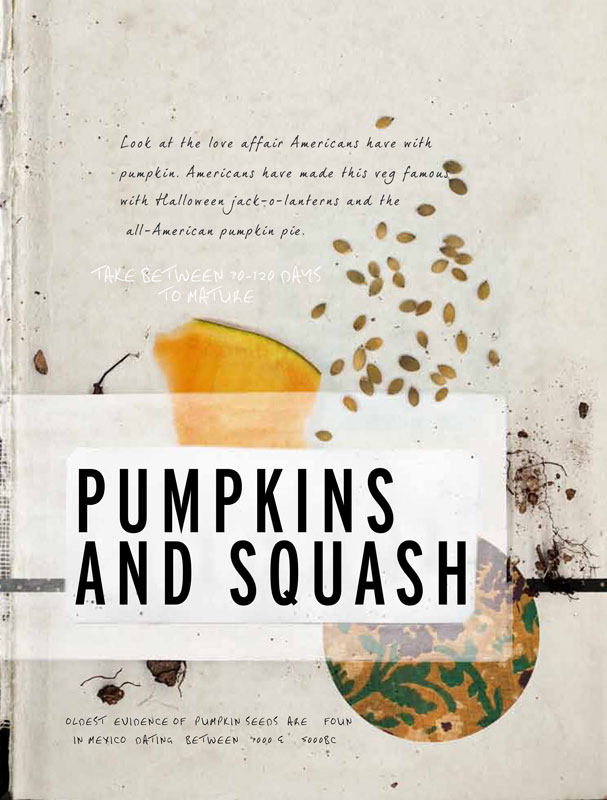
For pumpkin and squash to be included in here, among my all-time favorite vegetables is, to be completely honest with you, a bit of a revelation. I have nothing against pumpkin and squash itself, but culturally, to myself and many other Englishmen, they were always seen primarily as pigs’ fodder. And I’ll confess it took me a while to come to terms with eating them as a staple vegetable side. But once I was on the pumpkin and squash trail, I must admit to being jealous of those English pigs!
RECIPES
ROASTED BUTTERNUT SQUASH & HEIRLOOM CARROT, MACADAMIAS, CAPER & RAISIN DRESSING
BUTTERNUT SQUASH MASH WITH FISH FINGERS
It is strange to consider that the countries where pumpkin has been most heartily embraced are where I guess the options were limited. In Australia and America, the early settlers would have needed to have accepted and used the plants which would yield the highest return for their investment of labor because realistically the climates were tough and unlike anything they had seen before and the landscape would have seemed terribly barren and unfriendly. They had to embrace the things that would shield their families from the threat of starvation. It seems so remote now to us, with our supermarkets open all hours and food never far away, but this was a genuine concern to our forebears.
It is thought that pumpkin originated in America, and they have certainly made them famous with Halloween jack-o’-lanterns and the all-American pumpkin pie. In England we hollowed out turnips for All Hallow’s Eve for some reason. And I know for a fact that I had never even considered there was such a thing as a pumpkin scone before I arrived in Australia!
There is a natural sweetness within pumpkin that at times has notes of different spices like cloves or licorice. I like to add some licorice to my pumpkin purée to really enhance the aniseed flavor that is already there. The great thing about it is, like potato, it can be cooked just about every way: steamed, roasted, thinly sliced or broiled. Just don’t boil it, please. It loses all its integrity and turns into a horrid nondescript orange mush.
A lot of people forget that you can also use the seeds. Just wash and then dry them out in the oven or even in the sun. Toss these through a salad, either toasted or raw, for an interesting textural element. They also make a great garnish for cakes, like one of my favorites the hummingbird, with its lemony cream cheese frosting and lightly toasted shredded coconut. Alternatively, combine them with some of your favorite nuts and dried fruits as a homemade trail-mix snack. So versatile. And that’s just the seeds.
And surely if you have a child, pumpkin purée is a must. It has good vitamin A and C content, and is low in salt and saturated fat, making it a tasty, healthy option for young ’uns. It also contains considerable iron, making it a good choice for vegetarians.
Pumpkin obviously works well as a side with any roast meat—it’s one of my favorites—but it is also an incredible match with seafood and salty meats, like salami or duck leg confit; the salt of the meat and the sweetness of the pumpkin enhance each other’s flavor wonderfully.
There really is a lot to love about pumpkin as a gardener. There are lots of different varieties to choose from, depending on your taste. If you prefer your pumpkin large, then select the Queensland blue (a.k.a. ironbark) or Japanese varieties, whereas if you like them small try the kent or the gem, which grow to about the size of an onion. My favorite is the butternut squash, which is nutty, sweet, a great all-rounder and the best choice for cakes or biscuits. The skin is so thin you can leave it on when roasting to add flavor and texture.
One word of warning when considering growing pumpkin: when you’ve selected your variety and bought the seedlings at the nursery, now, unless you have acres of space, just plant one of the seedlings (often they come in threes). Trust me. Once the seedling has established, it grows like a weed! And if you let it, it will not only take up a lot of room but it will also climb pretty much everywhere. You can train it and point it in a certain direction and, if you like, it will grow up a tree or up a fence. Remember to keep cutting the vines back, though, or your neighbors will end up with all your pumpkin! For all the space that the plant does require, they really don’t produce that much fruit, but they are so tasty, it’s definitely worth it.
And, once the season is over for the year, make sure you save yourself some seeds from the fruit. You can dry them out in the sun, then put them in an envelope, and don’t forget to write down which variety they are for replanting next year.
Pumpkin can also assist in keeping a healthy garden. Save the waste or skin to use in your compost as it breaks down very quickly.
ROASTED BUTTERNUT SQUASH & HEIRLOOM CARROT, MACADAMIAS, CAPER & RAISIN DRESSING
SERVES 2 AS AN ENTRÉE SALAD OR 4 AS A SIDE
½ BUNCH HEIRLOOM CARROTS
1 BUTTERNUT SQUASH, PEELED, SEEDS REMOVED AND DICED
OLIVE OIL, FOR COATING
1 TABLESPOON HONEY
3 TABLESPOONS ROASTED MACADAMIA NUTS, CHOPPED
3 TABLESPOONS CHOPPED MINT
3 TABLESPOONS CHOPPED ITALIAN PARSLEY
7 OUNCES SOFT FETA CHEESE
1 TABLESPOON SALTED BABY CAPERS, RINSED
1 TABLESPOON RAISINS, SOAKED FOR 5 MINUTES IN WARM WATER, THEN DRAINED
3 ANCHOVY FILLETS
1 RED BIRD’S EYE CHILI, HALVED, SEEDS REMOVED AND CHOPPED
1 GARLIC CLOVE, CRUSHED
5 BASIL LEAVES
2 TEASPOONS BALSAMIC VINEGAR
JUICE OF ½ LEMON
⅓ CUP EXTRA VIRGIN OLIVE OIL
SEA SALT AND FRESHLY GROUND BLACK PEPPER
For the caper and raisin dressing, add all the solid ingredients to a large mortar and pound to a sticky paste consistency. Add all the liquid ingredients and taste for seasoning. Add salt and pepper if needed but remember the anchovies and capers are naturally salty. Set aside.
Preheat the oven to 375°F. Peel the carrots, place in a saucepan of cold salted water and bring to a boil, then drain. Place the squash in a large roasting tray and generously coat with the olive oil. Roast for 10 minutes, turning once, then throw in the semi-cooked carrots and roast for a further 10 minutes or until they are both cooked. Brush with the honey and place in a bowl to cool.
Once at room temperature, dress the vegetables with some of the caper and raisin dressing and toss with some of the macadamias and some of the herbs. Place neatly into desired bowl, then garnish with the remaining macadamias and herbs, a little more of the dressing and crumble over the feta cheese.
BUTTERNUT SQUASH MASH WITH FISH FINGERS
SERVES 4–6 (PLUS SPARE FISH FINGERS FOR THE FREEZER)
Okay, okay, you got me on this recipe. It’s actually all about the fish fingers… but who doesn’t love a fish finger? The butternut squash mash part is easy and could go with anything. The fish fingers are a little tricky but the recipe makes plenty so freeze them for a later date or, for a less time-consuming preparation (but just as enjoyable), you can make the fish mixture into cakes.
3 LARGE GOOD-MASHING POTATOES, PEELED AND DICED INTO CHUNKS
6 CUPS MILK
3 POUNDS 5 OUNCES WHITE FISH TRIM (BONELESS OFF-CUTS, I’D ASK YOUR FISHMONGER FOR COD, CUT INTO ROUGHLY 2-INCH CUBES)
2 SPRIGS THYME
2 SPRIGS TARRAGON
½ CUP BUTTER
⅓ CUP ALL-PURPOSE FLOUR
2½ CUPS MILK COOKING LIQUID (READ THE METHOD TO FIND OUT WHY)
1 HANDFUL OF ITALIAN PARSLEY LEAVES, CHOPPED
FINELY GRATED ZEST AND JUICE OF 1 LEMON
LEMON WEDGES, TO SERVE
1 BUTTERNUT SQUASH (ABOUT 2 POUNDS 10 OUNCES), PEELED, SEEDS REMOVED AND CUT INTO CHUNKS
¾ CUP OLIVE OIL
SEA SALT AND FRESHLY GROUND BLACK PEPPER
1 HANDFUL OF ITALIAN PARSLEY LEAVES, FINELY CHOPPED
1⅓ CUPS ALL-PURPOSE FLOUR
6 FREE-RANGE OR ORGANIC EGGS
¾ CUP MILK
3⅔ CUPS DRIED BREAD CRUMBS OR PANKO (JAPANESE) BREAD CRUMBS
VEGETABLE OIL, FOR DEEP-FRYING
This process for making the fish fingers is tiresome, but well worth it. You’re basically going to cook the spuds, cook the fish in the milk with the herbs, then combine the milk from cooking the fish with the butter and flour to make a white sauce to bind it all together.
Place the potato in a 8-Cup capacity saucepan and fill with cold water until it reaches the brim of the spuds. Bring to a boil, then turn down the heat to medium and cook for 12–14 minutes or until tender. Drain, put the potato back in the pan, place over low heat and allow to dry out for 1–2 minutes. Mash or pass through a mouli. Place in a large bowl and cover with a tea towel until ready to use.
While the potatoes are cooking, place the milk in a separate 8-cup capacity saucepan over medium heat and bring to a simmer, whisking occasionally so the milk does not scorch on the base of the pan. Add the fish, thyme and tarragon, turn down the heat to low and cook for 8 minutes, then take off the heat and leave to cool. Using a slotted spoon, carefully remove the fish and flake into the bowl with the potatoes. Cover the bowl. Pass the milk through a strainer and reserve 2⅓ cups. Discard the rest.
Wash the pan that you cooked the potatoes in, add the butter to the clean pan and melt over low heat. Add the flour and cook for 3 minutes, stirring with a spatula or wooden spoon to mix the flour in. Add ¾ cup of the reserved cooking milk and stir until it is fully incorporated, then get a whisk and begin slowly adding the remaining cooking milk, whisking constantly until you have used up all the milk and you have a smooth, lump-free mixture—you just made a white sauce.
Add the white sauce to the potato mixture, along with the parsley and lemon zest and juice, and mix thoroughly. Now you can choose one of two routes. You can mold the mixture into cakes or whatever shape you desire, then chill in the fridge until firm and set before crumbing and cooking. Or you can make fish fingers. If it’s the latter, then line a tray (measuring 12 × 8 × 1¼ inches) with parchment paper and spread the mixture evenly over the base, pressing it down until it is all level and smooth. Place in the freezer for 1–2 hours or until it is semi-hard. Remove from the freezer and cut the mixture in half lengthways, then cut each half into 12 fingers, so you should have 24 fingers (about 4 × 1 × 1¼ inches). Place the fingers back in the freezer for another 3 hours or until totally frozen. Freezing the fish fingers will make it easier to crumb and pan fry them.
For the mash, preheat the oven to 425°F. Place the squash in a large roasting tray, coat with ¼ cup of the olive oil, season with salt and pepper and roast for 30–35 minutes, shaking a few times during cooking. Take out of the oven and transfer to a large saucepan. Place over low heat, add the remaining olive oil and, using a fork, roughly mash up the squash. Check the seasoning. Just before serving, stir through the parsley.
When you’re ready to crumb the fingers, place the flour in a tray or bowl. Whisk the eggs and milk together in a bowl and put to the side. Lastly put the bread crumbs in a bowl or tray.
Working with one fish finger at a time, dip each into the flour, then the eggwash, the bread crumbs, back into the eggwash, finally into the bread crumbs again and place on a tray. (Two fish fingers per person is a good amount. You can refreeze any extra fish fingers after this crumbing stage to save for later.) The crumbing is tedious and messy, so here are my tips: use one hand for the liquid part (eggwash) and the other hand for the dry parts (flour and bread crumbs), or get the missus, old fella or the kids off the couch to come help you. (It could be more fun this way.)
Turn down the oven temperature to 400°F. Heat the oil in a deep-fryer to 350°F or in a deep saucepan (no more than one-third full) and fry the fish fingers, in batches, for 3 minutes or until golden. Drain on paper towels, then place in the oven for 4 minutes or until warm in the center. Serve with the warm mash on the side and lemon wedges for squeezing over.
1 Add the white sauce to the cooked fish and potato mixture.
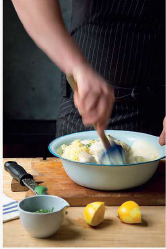
2 Add parsley and lemon zest and mix well.
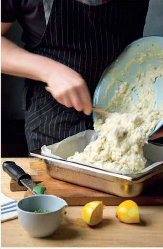
3 Pour fish and potato mixture into a lined baking sheet.
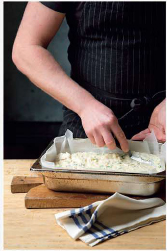
4 Press down firmly until the mixture is level and smooth, then place in freezer.
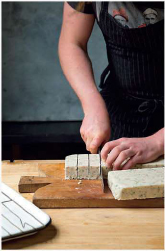
5 Turn fish and potato mixture out onto a board and cut into 24 fingers.
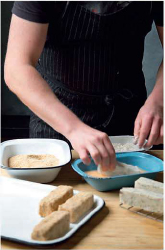
6 Dip each fish finger into flour, eggwash, bread crumbs then back into the eggwash and bread crumbs again. Deep fry immediately then finish in the oven (or freeze for later use).
PUMPKIN & YOGURT PURÉE
MAKES PLENTY BUT NOT TOO MUCH
It’s simple but don’t be fooled. It’s a great purée to accompany many meat and fish dishes. It’s also an easy dip or baby food (but don’t go adding the salt or sugar).
1 SMALL SUGAR PUMPKIN, PEELED, SEEDS REMOVED AND CUT INTO SMALL CHUNKS
3 TABLESPOONS OLIVE OIL
½ TEASPOON UNREFINED LIGHT BROWN SUGAR
⅓ CUP ORGANIC SHEEP’S MILK YOGURT
FINE SEA SALT AND FRESHLY GROUND BLACK PEPPER
Preheat the oven to 400°F. Place the pumpkin in a large roasting tray and coat with the olive oil. Roast for 20–25 minutes or until really soft. A few minutes before you take it out of the oven, sprinkle over the sugar, stir it around and place it back in the oven to finish cooking for about 5 minutes. Transfer to a blender and blitz with the yogurt until a smooth purée. Add salt and pepper and it’s ready to go.